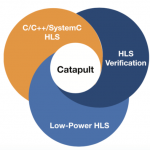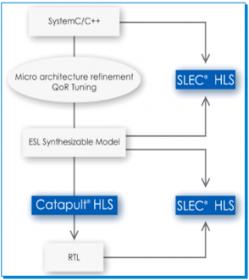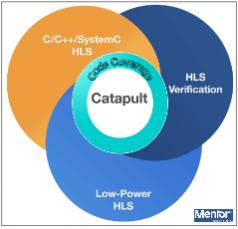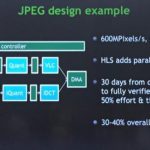It was refreshing to hear a talk focused on emerging stronger from the downturn when the news and media are focused on the gloom. At the recent Siemens EDA User2User conference, Joe Sawicki, executive vice president, IC, gave an uplifting keynote talk to the audience. He highlighted a secular growth trend happening in the semiconductor… Read More
Tag: high-level synthesis
Synopsys Presents SAT-Sweeping Enhancements for Logic Synthesis
There was a “research reviewed” panel on Thursday at DAC entitled Shortening the Wires Between High-Level Synthesis and Logic Synthesis. Chaired by Alric Althoff of Tortuga Logic, the panel explored methods to deal with wire delays in high-level synthesis and logic synthesis. The four speakers and their focus were:
- Licheng
Mentor Highlights HLS Customer Use in Automotive Applications
I’ve talked before about Mentor’s work in high-level synthesis (HLS) and machine learning (ML). An important advantage of HLS in these applications is its ability to very quickly adapt and optimize architecture and verify an implementation to an objective in a highly dynamic domain. Design for automotive applications – for … Read More
Specialized AI Processor IP Design with HLS
Intelligence as in the term artificial intelligence (AI) involves learning or training, depending on which perspective it is viewed from –and it has many nuances. As the basis of most deep learning methods, neural network based learning algorithms have gained usage traction, when it was shown that training with deep neural network… Read More
Sequential Equivalency Checks in HLS
Higher level synthesis (HLS) of an IP block involves taking its high-level design specification –usually captured in SystemC or C++, synthesizes and generates its RTL equivalent. HLS provides a faster convergence path to design code stability, promotes design reuse and lowers front-end design inception cost.
HLS and Mentor… Read More
Closing Coverage in HLS
Coverage is a common metric with many manifestation. During the ‘90s, both fault and test coverage were mainstream DFT (Design For Testability) terminologies used to indicate the percentage of a design being observable or tested. Its pervasive use was then spilled over into other design segments such as code coverage, formal… Read More
High-Level Synthesis for Automotive SoCs
Some of the world’s most complex Systems-on-Chip (SoCs) are being developed for automotive applications. These SoCs have heterogeneous architectures with a variety of processors and accelerators that do real-time image processing for assisted and autonomous driving applications. The Bosch Visiontec team, in Sophia Antipolis,… Read More
Xilinx is a Software Company
If you think of Xilinx the word that immediately comes to mind is FPGA. After all they were one of the pioneers of the space. FPGAs are a means of implementing hardware, and the main implementation methodology is RTL-based. This compares to writing software and compiling it for a microprocessor, which is the main software implementation… Read More
High Level Synthesis. Are We There Yet?
High level synthesis (HLS) seems to have been part of the backdrop of design automation for so long that it seems to be one of those things that nobody notices any more. But it has also crept up on people and gone from interesting technology to keep an eye on to getting genuine adoption. The first commercial product in the space was behavioral… Read More
NVIDIA and Qualcomm Talk about High Level Synthesis, Samsung on Low Power for Mobile
Since 1978 I’ve seen many trends in the semiconductor design world: transistor-level IC design, gate-level design, RTL coding, High Level Synthesis (HLS) and IP re-use. We’ve witnessed the growth in design productivity enabling chips starting with just thousands of transistor all the way up to billions of transistors… Read More









